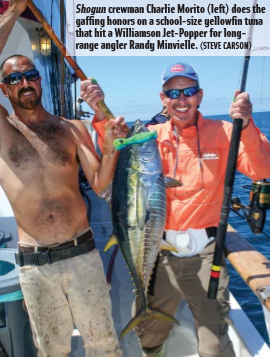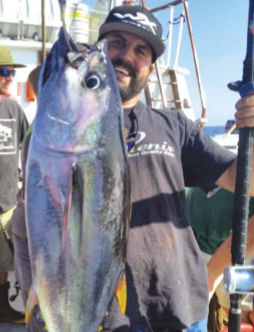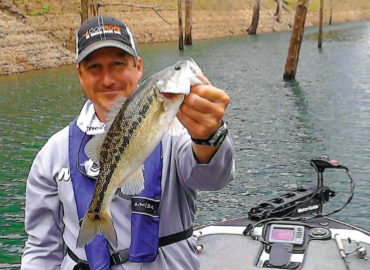The Barracuda Question
While catches of exotics are on the rise, these Toothy Fish have been mysteriously absent. Could they return?
By Steve Carson
The last couple of years have seen unprecedented action for California saltwater anglers due to a strong El Niño. Highly desirable pelagics like yellowtail and tuna, along with true exotics like wahoo and blue marlin, have been dominating the headlines and anglers’ attention. Over the past 50 years, barracuda catches have fluctuated up and down considerably, as has the species’ popularity. In the late 1960s, Southern California party boat operators ranked barracuda as the No.1 species that drew anglers to their ticket offices. The last few years have seen a combination of fewer barracuda and diminished effort as anglers chased after abundant yellowtail and tuna. As the population of anchovies in California waters increases, it’s hoped that the substantial barracuda population in northern Baja will come back up within range of local anglers.
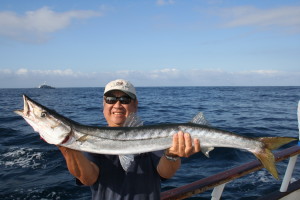
SEASONALITY
In non-El Niño years, the barracuda would start to show up in San Diego waters in early April. They continued to move northward along the coast and then spread to the offshore islands. May and June would often see huge areas of barracuda, from the Huntington Flats to Santa Monica Bay, and even to the Channel Islands. Local party boats would check in with hundreds of barracuda, and occasional heavy weekend crowds would score full 10-fish limits, totaling 500 or more barracuda. By mid-summer the fish would disperse, but catchable numbers were still around. Exactly how 2016 will play out re- mains to be seen.
TACKLE
California barracuda do not get especially large. The state record is just over 15 pounds, although there are moderately credible reports of fish in the 17-pound range being caught in the late 1940s. These days, anything over 10 pounds is a whopper, and typical legal school-size fish range about 4 to 6 pounds, with 8-pounders often taking the jackpot. As such, the main line can be only 15- to 20-pound monofilament, and private-boat anglers can easily get by with 10- to 12-pound mono. Spinning, baitcasting and conventional gear is all suitable for barracuda, although the presence of larger species mixed in with the school may dictate selecting heavier tackle. Some lures such as “surface irons” will also require specialized tackle for proper casting.
CASTING LURES
Most serious barracuda chasers tie on an iron jig like a Tady 45 or Tady C. Blue/white or chrome combinations are the most popular, but as always with surface iron, action is more important than color. Sometimes, deep-swimming schools simply won’t come up any higher than 75 to 100 feet, and yo-yo jigs like a Tady 4/0 or Sumo C2 can be sent down deep. A not-too-well-kept “secret” lure to pull out when the fish have seen everything is a chrome or blue mackerel-color 2¼-inch Krocodile. The Kroc’s exaggerated action and bright flash definitely trigger lethargic barracuda into biting. Cagey old-school anglers often tie on a feather jig with a hexagonal chrome head. Rigged on singlestrand wire and with a chrome torpedo sinker about 3 feet in front of it, this setup is deadly in the right hands. Barracuda will also readily go after soft plastic swimbaits of various styles and colors, and it goes without saying that their teeth are pretty destructive. A large percentage of barracuda will be under the 28-inch size limit in some areas. If possible, relocate when this happens, or at the very least minimize the damage done to short fish. Convert lures with treble hooks to single hooks, never grab the fish with a towel, and don’t let the fish hit the deck.
LIVE BAIT
Barracuda will go after a variety of live baitfish species, but for the most part prefer either anchovies or sardines best. As with most open-water species, the livelier the bait the better. Way back in the day, many anglers used “shorty” wire leaders for barracuda, and some tackle stores still sell them. However, wire leaders will often spook wary barracuda. Much more productive is a live bait-rigging trick made popular by the late Capt. Russ Izor. Using a basic three- or four-turn surgeon’s knot, attach a 4-foot piece of 30- or 40-pound fluorocarbon to your main line, then tie on your hook. Some fish will still manage to bite through the fluorocarbon, but for the most part, it will hold until the fish is landed. You will then need 4 to 6 inches of frayed line cut off and retied. Gradually the leader will grow shorter with each retie, and when it gets down to less than
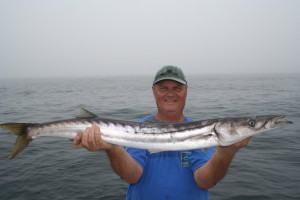
12 inches, start over with a new piece of fluorocarbon. Hook choices should match the bait, but heavyweight hooks are not needed. Some anglers claim to be able to use long-shank or circle hooks to just get the barracuda in the lip, but in practice this is inconsistent at best. A light-wire hook like the Owner Gorilla Light is perfect. Go with size 1 to 4 for anchovies, and size 1/0 to 4/0 for sardines.
TROLLING LURES
Specific trolling effort is not usually directed at barracuda, but they are often caught incidentally, primarily by anglers trolling for yellowtail. Almost anything with flash will draw a barracuda’s attention, but it would be hard to beat a silver/black Rapala in the XR15MAG or XR20MAG sizes for trolling, and those choices would also appeal to yellowtail
CARE OF THE CATCH
Of course, we are talking specifically about “California barracuda,” which is a highly edible species. The tropical species found in Florida and Hawaii known as “great barracuda” are generally not considered edible. After gently determining if the catch meets the 28-inch minimum-size requirements, private boat anglers should immediately bleed the catch by cutting a gill raker. Lay the fish out completely flat in an ice chest as quickly as possible; cover with crushed ice if you have it. Party boat anglers should take extra care their fish do not go awkwardly into the gunny sack, and end up in a stiff curved shape. An easy trick is to make a 6-inch loop of monofilament line after cutting a gill raker, attach it to the barracuda’s tail, then hang that from the same hook the gunny sacks hang from, letting the fish hang straight down. Barracuda can be steaked out, but are more often filleted. The flaky white meat can be baked, broiled, fried or barbecued. The legal bag limit is 10 fish, with a minimum length of 28 inches. Barracuda do not freeze especially well, so take home only what you can consume while fresh, and then go out and catch more.
Editor’s note: Email the author at scarson@sunset.net.

